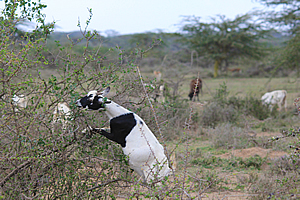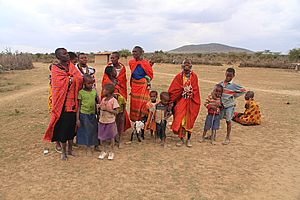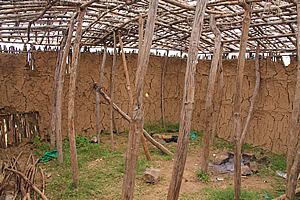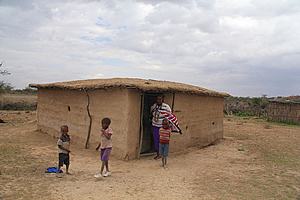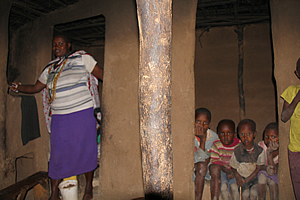--- Archive files ---
Home > Travels > Masai Mara > 5 |
Huts Built From Cow Poo
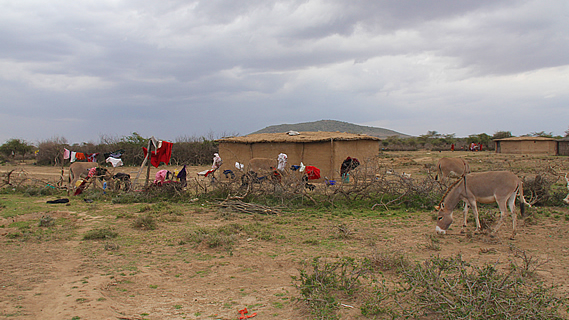
BY NOW we had come some distance and we were heading away from the eco camp again. We reached the dirt road Joseph had driven along upon leaving the main road to reach the eco camp. We crossed over the road and continued walking through the scrub for another five hundred metres until I saw movement ahead. It was a herd of goats with some Masai men leading them. Luke explained these were very important to the Masai, so important in fact that it was considered to be their currency.
Herd of domesticated goats |
We found some more plants, including the sandpaper tree with small abrasive leaves they use to sharpen and smooth their spears. There was also the tissue tree with soft leaves they use to clean their armpits. So that’s what they used before aerosol deodorant was invented. The branches of this tree were long and straight and almost horizontal. These branches went out in all sorts of random directions, but they were a good two metres long and quite straight and strong. The women of the villages build their houses using these branches. Yes, the women were the builders in this culture.
Villagers |
We finally reached their village. It was fenced with poles from the tissue tree. There were a number of rectangular mud huts inside. A group of women and children, all completely bald and wearing bright colours but no shoes, assembled in front of me to perform a welcome song and dance. Apparently it is traditional for the Masai to do a welcoming performance whenever visitors arrive. I’m not sure whether they did it to attract more money or not, but I told Luke that I had left my wallet locked up in the tent (and I had the key with me). I had no idea there was any potential for spending money out here. Luke said that was fine. Most people do tip out here, but they don’t expect it as they are paid well from the money made by the eco camp. Following the dance they led me into an unfinished house where only the framework was complete.
Inside an unfinished house |
The house was pretty solid. Luke explained to me that the wooden frame will last ten years. The house was divided into four rooms. One room just inside the entrance was for the livestock. So they live with their animals. Then they have a central room for the living area. This has a small fireplace dug on the floor against the back wall to provide light and warmth. On the left hand side of the lounge is a small alcove for the father to sleep. The right hand side has separate quarters for the mother to sleep, and back towards the entrance, for the children to sleep. Each room was tiny, the size of a wardrobe. My head almost touched the ceiling. Most of the internal outer walls were sealed with a mixture of cow dung, soil and water. The mud had dried causing it to crack in interesting patterns. Grass was still growing on the floor and cut branches were used as framework to hold up the ceiling. They were aligned to show where the internal walls were going to go. Luke said these houses last about ten years.
Family outside their house |
We then left this hut and entered a completed hut. The cow dung mixture was lined over the framework on both sides so as to hide all the timber, no doubt assisting its preservation. The layers were a good five centimetres thick. When constructed, it is left to bake in the sun to provide excellent weather proofing. I touched it. It was just like dried clay. I made a mental note to carefully wash my hands before my next meal, having just touched something that made from cow poo.
We entered the house to find a woman with her children sitting inside. I assumed this was their home. The only light was that which came through the tiny door we had entered, and from a few embers in the fireplace which filled the house with a permanent acrid smell despite though thankfully not too smoky. Just in front of the main door was a one metre high solid wooden door leading to the small room where the livestock sleep at night protected from the nocturnal predators here. We entered the tiny lounge and sat on some tiny stools around the fireplace. It was incredibly claustrophobic in there, being so dark, each room the size of a closet. Aside from the animal room, it was pretty open plan with the tiny bedrooms open into the lounge. The area of the entire house was about the area of my smallest spare bedroom at home.
Inside the Masai house |
I sat on a tiny stool as we briefly chatted to the family. The mother was sitting on her bed in her tiny alcove and the five children were all sitting in their tiny room which was hardly the size of a single bed. It was a very difficult existence living here. I wondered if these people had any idea of the mansions that we Westerners live in.
From there we left the village and walked along the track through the scrub towards the eco lodge until reaching the dirt road we had earlier driven along. Outside the village I saw a very brightly coloured blue starling. We walked along it for about ten minutes through the scrub before arriving back at camp.
<< Previous | Next >> |
|
||
About this Page
|
||
|
|
|
Where is Walkabout Jeff? |
|
|
|
|
What is happening in Walkabout Jeff's hometown?
|
|
|
|
|
Who is Walkabout Jeff?Any normal person's idea of going out involves going to the local pub for a drink with a few mates. Walkabout Jeff isn't normal.
|
|
|
|
|
